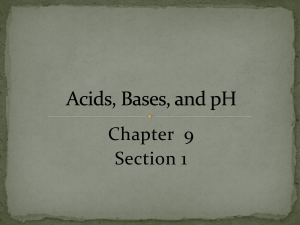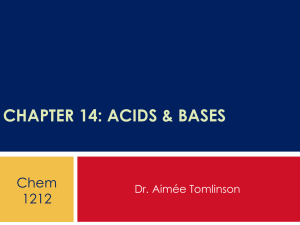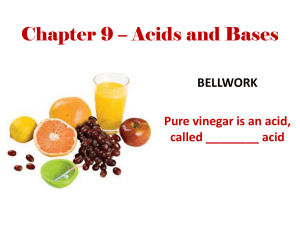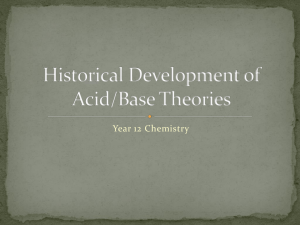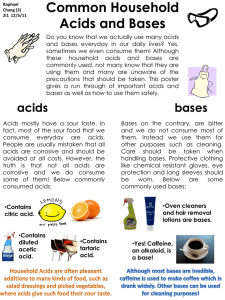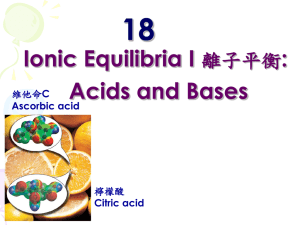Chapter 13
advertisement
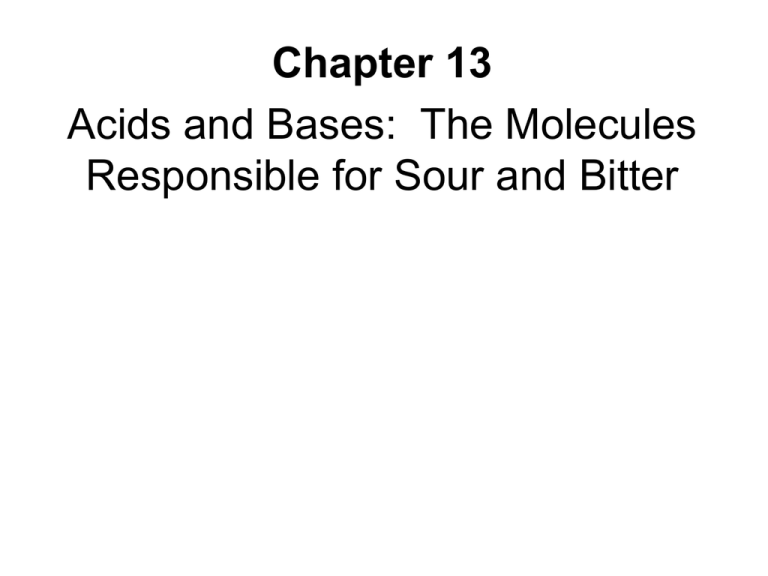
Chapter 13 Acids and Bases: The Molecules Responsible for Sour and Bitter Introduction • Sourness in foods is caused by acids, molecules that release protons. • The chemical opposite, bases, are all around us. Properties of Acids • Acids do dissolve metals, but not with the speed alluded to in movies or television. Properties (continued) • Acids have the ability to react with bases to form water and a salt through neutralization reactions. • Acids turn litmus paper red. – Bases turn litmus paper blue. • Acids are considered to be dangerous materials. – Dissolve clothing, burn skin, damage gastrointestinal tract, kill Properties of Bases • Slippery feel • Bitter taste • Ability to react with acids to form water and a salt in neutralization reactions • Bases turn litmus paper blue. Properties (continued) • Bases are found in many cleaning products. • Burn skin and damage gastrointestinal tract on contact Molecular Definitions • Arrhenius – Acids produce hydrogen ions (H+) in solution. – Bases produce hydroxide ions (OH-) in solution. – But Arrhenius’ definitions do not apply in all cases. • What about ammonia? Definition (continued) • Brønsted-Lowry – Broader definition – Works in solutions that do not contain water – Focuses on the transfer of protons (H+ ions) – Both B-L equations here, the overall ones with HCl and then NH3 as reactants – In the Bronsted-Lowry definition, acids are proton donors and bases are proton acceptors. Strong and Weak • Acids that completely dissociate, like HCl, are strong acids. • Acids in an aqueous environment, that in large part remain undissociated, are weak acids. A double arrow indicates that the dissolution does not go to completion. In the same manner, bases are considered either strong or weak. H3O+ Concentration • The acidity of a solution is normally specified by the concentration of H3O+ in moles per liter of solution, M – Strong acids: acid concentration equals concentration of H3O+ – Weak acids: acid concentration is greater than concentration of H3O+ • Pure water has a H3O+ concentration of 1 x 10-7. The pH Scale Pure water with H3O+ concentration of 1 x 10-7 has a pH of 7. • H3O+ concentration greater than that of pure water is termed acidic. – pH values less than 7 • H3O+ concentration less than that of pure water is termed basic. – pH values greater than 7 For every change of 1 unit on the pH scale, [H3O+ ] changes by a factor of 10 Common Acids: Citric • Naturally occurring citric and other acids in acidic foods offer spoilage resistance. Lactic Acid • Fermentation with lacticacid-forming bacteria helps preserve low acid foods like cucumbers and cabbage. • This technique is called pickling. Acetic Acid • Vinegar is a solution of acetic acid in water. • Vinegar is from the French vin aigre, meaning sour wine. Oxygen will convert ethanol in wine to acetic acid. Salicylic Acid • Salicylic acid is a precursor to acetylsalicylic acid, aspirin, the most widely used of all drugs. Wine • All wines contain 0.60 to 0.80% acid content by volume. – From grapes and from fermentation • The balance of these acids determines the quality of the wine. Common Bases • Bases have a bitter taste. – Evolutionary adaptation that warns against (often poisonous) alkaloids? • Active ingredient in antacids – These are substances that dissociate in water to form a metal ion and a base. Common Bases (continued) • Sodium bicarbonate – Taken directly or as Alka-Seltzer • Calcium carbonate – Active ingredient in Tums • Magnesium hydroxide – Milk of Magnesia – laxative effect – In combination with Al ions (Mylanta): constipating effect to balance • Ammonia and sodium hydroxide – Household cleaning products Baking • Baking powder is used to produce carbon dioxide gas pockets in dough, making the baked product lighter and fluffier. – sodium bicarbonate – sodium aluminum sulfate – calcium acid phosphate • Acidic salts combine with the basic salts making carbon dioxide and water. – Warm carbon dioxide gas expands during baking. Yeast produces CO2 and ethanol for a similar effect with breads. Acid Rain: Fossil Fuel Combustion • SO2 and NO2 formed during fossil fuel combustion combine with atmospheric water to form acid rain. • Unpolluted rain is slightly acidic due to atmospheric carbon dioxide. • Most acidic rainfall occurs in the northeastern U.S. Acid Rain: The Effects • The environment into which acid rain falls determines its fate. • In some cases naturally occurring geography can serve to neutralize the acid. • Rapid acidification occurs when neutralization is not possible. • Lakes and Streams – Approx. 2000 lakes and streams in the eastern U.S. have elevated pH. – Some aquatic species cannot survive. – U.S. emissions have contaminated Canadian lakes. • Building Materials – Acids dissolve stone, marble, paint – Rusting of steel is accelerated • Forests and Reduced Visibility – Trees cannot grow and fend off disease. – Sulfate aerosols account for 50% of visibility problems in the eastern U.S. Clean Air Act Amendments • Cut SO2 emissions to half of 1980 levels by 2010 – Use low-sulfur coal, rremove sulfur before burning – Use flue gas scrubbers – Conservation and efficiency of customers • SO2 emission allowances – Can be traded among utilities but congress reduces number of allowances as per regulations • Conjugate acid and base pairs • An acid reacts with a base to form the conjugate base of the acid and the conjugate acid of the base • - the two substances only differ by a hydrogen ion, H+ • Examples stronger acid weak base t han ammonium ion H2O Acid + NH3 Base weaker acid t han water strong base + NH4 + OH Conjugat e Acid Conjugat e Base of Ammonia of Water weaker base stronger acid weaker acid t han bicarbonat e t han carbonic acid stronger base t han hydroniumion t han water + H2CO3 Acid + H2O Base H3O + HCO3 Conjugat e Acid Conjugat e Base of water of Carbonic Acid • ion product for water (Kw) - the product of hydronium and hydroxide ion concentrations in pure water • Kw = Ka[H2O] • Kw = [H3O+] [OH-] • = [1.0x10-7 M][1.0x10-7 M] • = 1.0x10-14 M (at 25 °C) • Kw is the same value for every aqueous solution • acidic solution [H3O+] > 10-7 M [OH-] < 10-7 M • neutral solution [H3O+] = 10-7 M [OH-] = 10-7 M • basic solution [H3O+] < 10-7 M [OH-] > 10-7 M pH pH = - log [H3O+] [H3O+] = 10-pH Acidic solutions (pH 0-6 or < 7) [H3O+] > 1x10-7 M Neutral solutions (pH = 7) [H3O+] = 1x10-7 M Basic solutions (pH 8-14 or > 7) [H3O+] < 1x10-7 M



